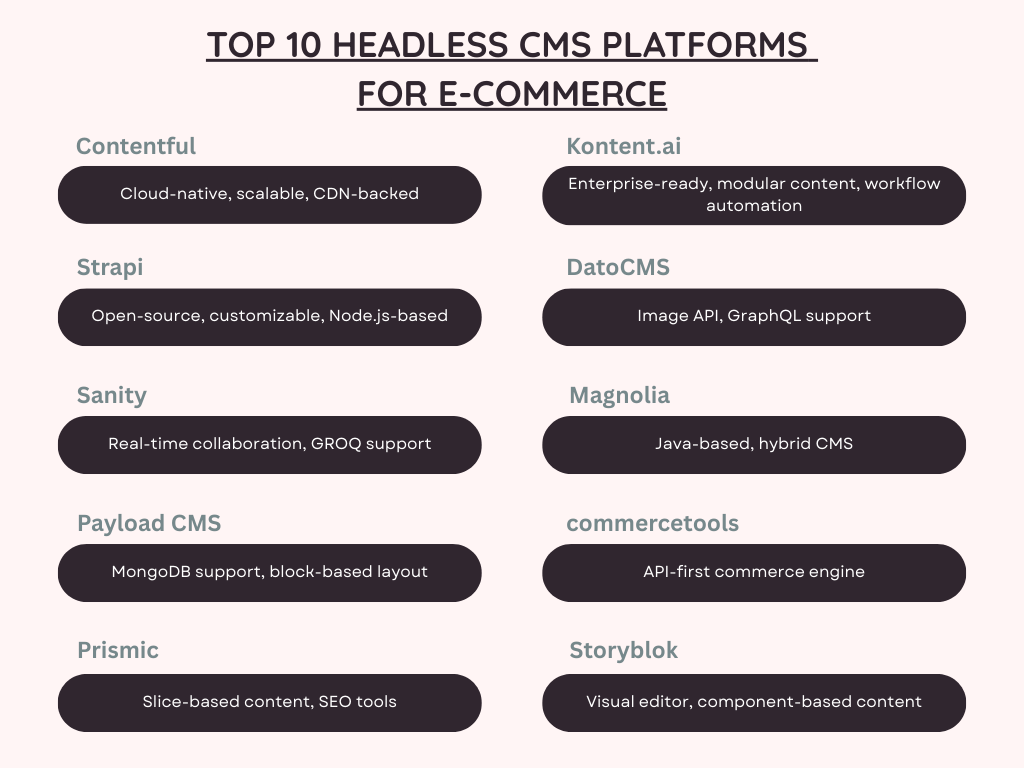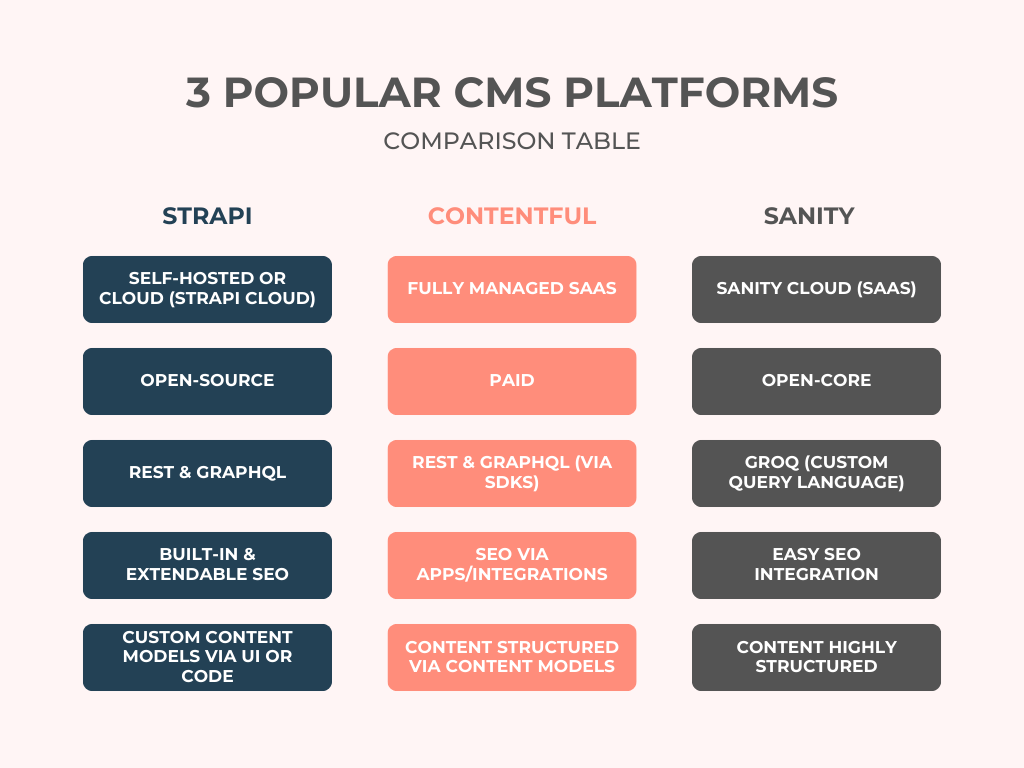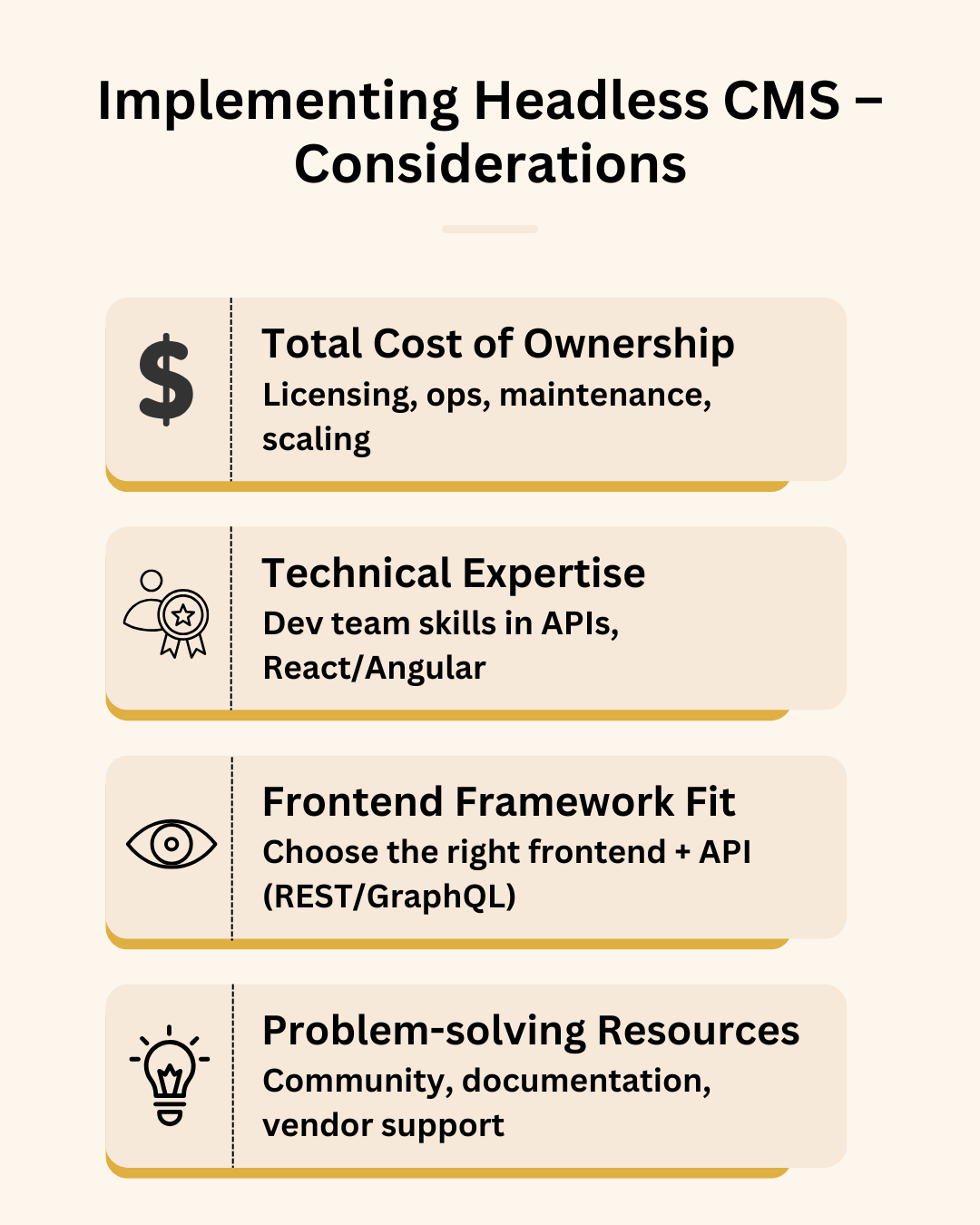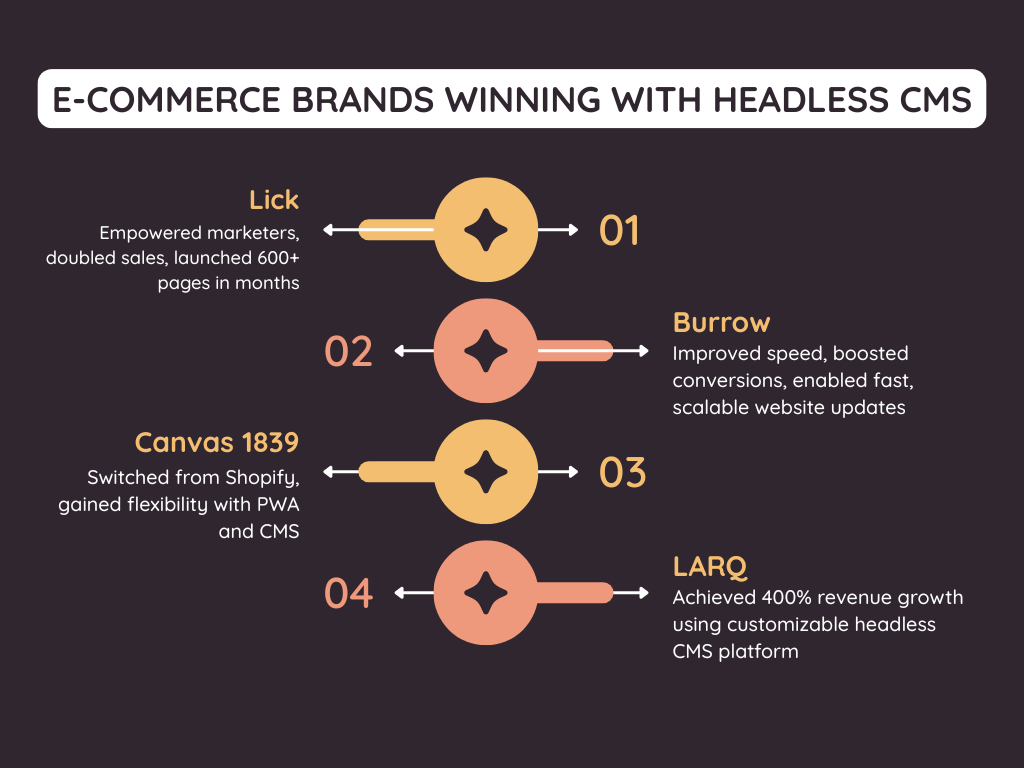Cohesive Omnichannel Strategy : Bridging eCommerce and In-Store Experiences


To “sell” more, e-commerce companies must “scale” faster. CMS platforms are no longer a passing trend, but a critical part of the backbone of success in the e-commerce industry.
A modern e-commerce system demands that its backend system is separated from its frontend design. Traditional CMS tools make it hard to scale because they tightly connect the content management with the front-end display. Headless CMS platforms offer a better alternative with their architecture that separates content from the display.
In this blog, we explore the top headless CMS platforms for e-commerce businesses and how they differ in features and benefits.
With a headless CMS, e-commerce developers can manage the content (back-end) and the user interface (front-end) separately. This allows them to use any front-end technology like React or Angular. The CMS acts as the data source that sends content to the frontend system.
A headless CMS can deliver the same content across different platforms, such as mobile apps, websites, and digital signage. It delivers content using APIs, which is quicker and more efficient than a traditional CMS that sends content directly to the server.
Now that we’ve discussed the role of headless CMS, let’s take a closer look at the top platforms for e-commerce.
Here’s an overview of the leading headless CMS platforms that are available for e-commerce companies in 2025:
Contentful is a popular headless CMS platform that provides a flexible, scalable architecture for e-commerce companies. It lets them easily create and distribute content for their online stores. This cloud-powered CMS is ideal for online businesses that are looking for a reliable and scalable platform.
Key features:
Developed on Node.js, Strapi is among the leading headless CMS platforms for e-commerce companies. With its enterprise-level features and user-friendly interface, this platform enables developers to build customized content types with efficiency.
Key features:
As a reputable headless CMS platform for e-commerce companies, Sanity offers amazing flexibility and scalability needed to manage online stores. When you choose Sanity, you can work with any frontend technology.
Key features:
Payload CMS is a powerful, headless content management system that offers a variety of tools for managing and accessing e-commerce content via APIs. This platform gives you benefits like easy integration, flexibility, scalability, and performance.
Key features:
Prismic allows e-commerce companies to build a headless commerce system that is both simple and efficient. Its slice-based content modeling enables companies to reuse content components, saving time and effort.
Key features:
Kontent.ai is an AI-powered headless CMS platform designed for e-commerce companies aiming to improve their content development. It offers structured content and workflow management, making it suitable for organizations with strict governance structures.
Key features:
With over 25,000 customers, DatoCMS is is a headless CMS platform for e-commerce developers to create and manage dynamic content for mobile apps and web applications.
It supports multiple languages and offers customizable content models.
Key features:
As a modern tool, Magnolia has adopted an hybrid approach to combine the capabilities of headless CMS technology with traditional CMS. What sets this platform apart is its composable Digital Experience platform (DXP), which provides a single unified interface to manage content across multiple channels.
Key features:
Commercetools is a cloud-native headless commerce platform with a microservices architecture designed for high scalability. The platform’s API-first approach ensures smooth integration with various frontend frameworks. This CMS is very useful for enterprises with complex product catalogs and a high volume of online transactions.
Key features:
Equipped with a visual editor, Storyblok provides a component-based approach for e-commerce teams to build and maintain their website content. Content creators without any coding skills can also use this tool to create and modify their content. With the use of content blocks, website developers can reuse UI components like teasers, grids, and feature sections.
Key features:


| Feature | Strapi | Contentful | Sanity |
| Hosting platform | Self-hosting or managed hosting | Cloud-based, fully managed SaaS host | Managed SaaS with self-hosting (optional) |
| Open-source | Yes – licensed to MIT | No | Yes |
| Database support | SQL and NoSQL – MySQL, PostgreSQL, MongoDB, SQLite | Managed database | Managed database on the cloud |
| API and query support | REST, GraphQL | REST, GraphQL | GROQ language, REST, GraphQL |
| Content structure | Flexible content types & relations, extendible plugins | Schema-based content structure, modular | Structured content, GROQ queries |
| Collaboration tools | Self-managed workflow, role-based user access, plugins | Real-time collaboration, reusable components | Real-time multi-user editing, localization |
| SEO support | Manual setup using plugins | SEO using structured content and plugins | SEO plugins, metadata, and custom fields |
| User experience (UX) | Customizable admin panel, developer-friendly, technical setup required | Business-centric UI, rich text commands, versioning | Customizable Studio, real-time collaboration |
| Use cases | e-commerce applications, CRM | Omnichannel delivery | Structured content and real-time editing |
Next, let’s discuss some considerations for e-commerce companies when implementing a headless CMS platform.
E-commerce companies must implement headless CMS with a full understanding of their business needs, plans, and potential challenges.

Here are 4 considerations to factor in when implementing this solution:
Beyond the licensing costs, e-commerce companies must consider TCO, which includes:
E-commerce companies must also consider the technical skills involved in switching to a headless CMS platform. For instance, the in-house development team needs full expertise in API programming and modern frameworks like React or Angular. Besides that, companies incur initial setup costs arising from custom development and integration work.
Headless CMS can be implemented on any supported frontend framework. That said, e-commerce companies must have a clear understanding of which framework is best suited for their requirements. This selection is largely influenced by their probable use cases and the technical expertise of their development team.
Besides the frontend, companies must also contend with the type of APIs – REST or GraphQL – to deliver content to third-party applications.
For seamless functioning of a headless CMS platform, companies must have access to problem-solving resources in the post-implementation phase. This includes resources in the form of community forums, development documentation, and technical helpdesks.
Here are 4 case studies of e-commerce companies successfully implementing Headless CMS for their benefit:

Lick, a leading e-commerce brand in consumer goods, implemented headless CMS to develop custom models, which enabled product marketing teams to create e-commerce pages (without any developer’s assistance). The entire project was completed from idea to launch in just 6 months. On completion of this project, the company doubled its online sales and successfully managed over 600 product pages.
This direct-to-consumer furniture brand was established to overcome the hassles of traditional in-store shopping. With rapid business growth, the company implemented a headless CMS to improve its scalability and quickly customize its website. Post implementation, the company increased its conversion rate by 30% in just 2 months and its website speed by 50%.
This Austin-based company is in the business of selling cannabidiol-based creams and lotions. With their previous platform, Shopify, the company was limited in its choice of payment providers and other use cases. Using headless CMS, this retail company switched to a progressive web application (PWA), which provided the flexibility needed for frontend innovation. Canvas’s application developers can also use frontend tools like Gatsby, React, and GraphQL to improve their user experience.
Among the leading sellers of self-purifying water bottles, LARQ is focused on environmental sustainability and clean water initiatives. The company needed a highly scalable platform to match their business growth, which could also deliver customization. By implementing headless CMS, the company increased its revenues by 400% and conversion rate by 80% in just three months.
Headless CMS platforms provide e-commerce companies the flexibility and scalability to boost their business growth in a competitive domain. An e-commerce solution provider like RBM Software can help online retailers transition smoothly to this new system.
With years of expertise in headless commerce, RBM software can help you accelerate your time-to-value while cutting down your implementation risks. If you’re looking for a forward-looking content strategy, contact us for a comprehensive evaluation.